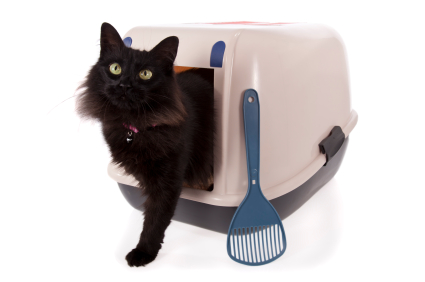There are a lucky few of us with indoor cats that haven’t had to deal with messes outside the litter box. Failing to use the litter box is the top behaviour complaint of cat lovers, resulting in countless cats being sent to shelters every year.
Frustration is understandable. Cat urine is foul smelling and can be difficult to clean. Even surfaces that appear and smell clean can still harbor urine which attracts your cat to urinate there again. It’s an overwhelming problem that takes patience and time to determine what is causing the problem.
There are four basic causes of house soiling in cats:
Environmental and Social Factors:
- Cats are very clean by nature and need adequate unsoiled locations to eliminate, especially in a multi-cat household. If their litter box is dirty, they may look for another place to go (similar to us in public washrooms).
- Some cats may avoid a litterbox in high traffic areas, near cat doors, or near its food or water
- In multi-cat households a more dominant cat by the litterbox may cause a less confident cat to eliminate elsewhere
- Cats may not use the litterbox if they had a bad experience in or near it (children or family members trapped them in there for some reason, a loud noise startling them while they’re in there, or a dirty litter box)
- Cats may be particular about box type or litter type. A covered box may seem scary or an uncovered box may not be private enough. Cat litters come in different substrates and scents that can be seen as offensive to the cat.
Marking Behaviour
- Urine spraying is a natural feline behaviour in which cats mark their scent. Marking behaviour can also include scratching, rubbing, and depositing feces.
- Unspayed females and unneutered males will mark as part of their sexual behaviour. Spaying and neutering can drastically reduce this behaviour.
- Cats may mark because of anxiety due to changes in their environment.
- Cats may target items in the house with new or unrecognizable smells like shoes or backpacks.
- Marking near windows or doors can indicate a threat perceived from outside. Marking other parts of the house can indicate perceived threats from inside the home such as new pets/people, renovations, or children’s activity.
Medical Causes and Problems
- Medical issues can cause behaviour changes such as house soiling. This is the first thing that should be ruled out when problems arise. Your veterinarian will be able to diagnose or rule out any medical conditions that could cause the behaviour. A thorough exam and urinalysis will be performed to check for problems such as urine infections, cystitis, arthritis, kidney problems, diabetes, and other medical issues.
- If your veterinarian believes the behaviour is from a medical issue, he or she may perform additional tests such as a urine culture, abdominal radiographs, and blood work to further investigate.
Feline Idiopathic Cystitis
- FIC is a frequent medical cause of house soiling in cats. It causes increased frequency of urination, difficulty and pain while urinating, and often blood in the urine. It is an inflammatory condition that can increase and decrease in severity over time and is aggravated by stress, changes in diet, and other issues.
If medical conditions have been ruled out, then you can focus on your cat’s environment and his or her behaviour. The design and management of the litter box is integral to promote good elimination habits
5 Considerations for Litter Boxes
1. Number
There should be a litter box for every cat in the house, plus one. They should be spread in multiple locations of the house. Cats that are familiar with each other and exhibit behaviour such as grooming/playing/resting together may be willing to share a litter box. There can be more than one social group in the multi cat household so it is important to have resources available for each.
2. Location
Avoid placing it near food or water sources.
Put it in a quiet, private place. The cat should be able to see what is coming when he or she is in the box. Avoid areas that can be blocked off with no means of escape (dominant cats can block access to or from the litter box at the end of a hallway for instance)
Spread boxes out. Your cat sees two litter boxes beside each other as equal to one big one.
Try placing the litter box in the place your cat is soiling.
If there are multiple levels in your house, put a box on each level.
3. Size
Bigger is better! The box size should be 1.5X the length of your cat from nose to the base of the tail. Most commercial litter boxes are not big enough. Good alternatives are storage containers or trays. Cut an entrance into the tall containers. Make it low for older cats with mobility issues.You can have a variety of covered and uncovered containers.
4. Litter
Your cat may have a preference for different litter substrates. Try different types of litter until he or she indicates a preference. Also try different depths of litter. Often cats dislike aromatic or dusty litters, deodorizers and box liners.
5. Management
Remove waste at least once a day and add litter as needed. Scrub the box clean AT LEAST monthly using hot water and soap only. Avoid harsh chemicals or ammonia based products.
If all else fails you may have to retrain your cat by keeping him or her in a confined area like a guest bathroom for a while. Make sure there are no other good options to use besides the litter box (carpet, pile of dirty laundry etc). You can block off the bathtub or keep a small amount of water in it to discourage its use. Once the cat is reliably using the litter box you can gradually expand his or her territory again.
Your St.Albert veterinarian at Mission Ridge Animal Hospital can help you with any questions you have and to formulate a personalized plan of action.



